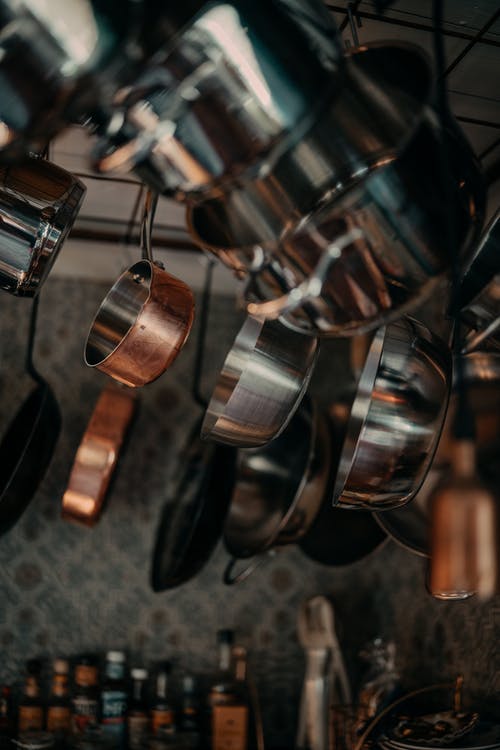Sound health relies on a quality diet, and a quality diet mostly depends on healthy cookware. A cook should be aware of what cookware is safe to use while cooking any dishes. The dietary benefit of food can be effectively demolished for the need of naturally developed food, liberated from pesticides and other harmful chemicals. For avoiding, destructive chemicals, toxic-free cookware is a fundamental piece of good cooking and is profoundly significant in keeping you and your family healthy.
In this article we will discuss the good sides and bad sides of the top 5 types of cookware according to Living Indoor blog and you will understand which cookware is right for you.
1. Aluminum Cookware
Aluminium is a genuinely lightweight metal that conducts heat quickly. Aluminium is an extraordinary warmth conductor, which implies that your dish will warm up rapidly and cook food equitably. It’s additionally accessible to perfect and reasonable. Aluminium cookware is only that pots and skillet produced using aluminium. They can likewise be nonstick covered or anodized, implying that the skillet won’t respond with acidic food items.
Good Sides
Aluminum cookware is a well-known choice since it’s moderately cheap.
Bad Sides
Aluminum cookware, particularly non-anodized, isn’t as healthy as choices prefer cast-iron or artistic. Watch for scratching and consumption with this sort of cookware. Aluminium cookware is quite low-stick, yet not nonstick. You’ll have to cover the outside of your container with oil to forestall staying.
2. Stainless Steel Cookware
Stainless steel is a metal compound that contains typically iron, chrome, and nickel as a healthy cookware stainless because it’s impervious to rust and consumption, which makes it an excellent material to cook. Stainless steel will, in general, disperse heat equitably over its surface, making it particularly extraordinary for iron cooking and level preparing sheets. It’s additionally cheap contrasted with some different materials. Treated steel that will be solid and stand the trial of time consider discovering items that have a copper or aluminum-based center.
Good Sides
Stainless steel is entirely resistant to scratches, dings, and erosion. When appropriately thought about, it will last you years.
Bad Sides
Stainless steel cookware represents a danger of filtering. While tempered steel does not treat with a compound covering, it includes an amalgam containing nickel and chromium. At the point when you’re cooking acidic food items, for example, pureed tomatoes, filtering can be a worry.
3. Titanium Cookware
Titanium cookware demonstrates to be protected and doesn’t represent any hazard to human wellbeing. Titanium cookware is not amenable, nonstick, non-absorbent, and scratch-safe. Titanium is exceptionally light and amazingly stiff. Titanium cookware utilizes an aluminium base for ideal warmth appropriation. Being, non-permeable, the titanium layer keeps aluminium from spilling into the food, and it is additionally dishwasher fitting. The fundamental disadvantage is that Titanium cookware is extravagant.
Good Sides
This safest material for cookware is exceptionally light but hard in nature. This cookware is also dishwasher friendly and as it is nonstick so more comfortable to clean.
Bad Sides
Titanium cookware is highly-priced comparatively to other cookware.
4. Ceramic Cookware
Ceramic pots and dish are made of metal and covered with a nonstick material that has a clay base. Ceramic cookware should clean by hand, and a few purchasers state that it doesn’t direct warmth equally over its surface. This cookware professes to be greener, better and healthiest cookware for the earth; however; its production rate is not that higher. This toxin-free cookware is in all probability safe. Be that as it may, ceramic cookware protects its surface at higher temperatures than conventional Teflon nonstick pots and dish.
Good Sides
Ceramic cookware usually is nonstick and doesn’t drain or emanate conceivably unsafe exhaust. Along these lines, ceramic cookware is among the best toxin-free cookware alternatives. It’s an eco-friendly choice that will keep going for a considerable length of time whenever looked after appropriately.
Bad Sides
Ceramic cookware is not completely nonstick, and it is better to use some oil while cooking. This environment-friendly cookware is also comparatively pricey.
5. Nonstick Cookware
Nonstick cookware is any cookware covered with a nonstick surface, delivering it greasy and jumble free. Nonstick is a class that can incorporate various finishing and materials to make a pot or container discharge prepared food from its surface all the more without any problem. Nonstick customarily and regularly alludes to a restrictive covering called Teflon.
Good Sides
The nonstick cookware considers simple tidy up and speedier cooking. Everything you require to do even in the wake of preparing a messier dinner is flush with water or crash with a clammy fabric. This safe cookware is also inexpensive.
Bad Sides
The covering on some nonstick cookware can radiate harmful exhaust whenever warmed past 450-500 degrees. Although a few brands guarantee to be dishwasher-safe, consistently placing this cookware in the dishwasher can harm the covering.
Final Words
There are of numerous choices accessible for cookware now. Regardless of whether you pick an organizing set or what cookware is safe to use, consider what you cook frequently and choose your cookware dependent on that. Be that as it may, to cook at home, you have to have the correct cookware.

